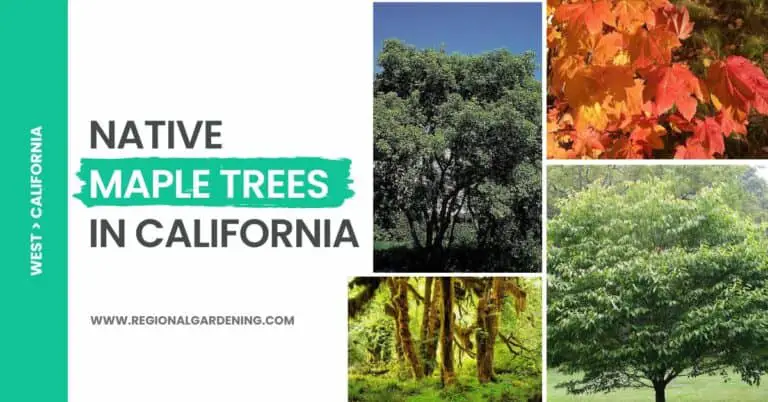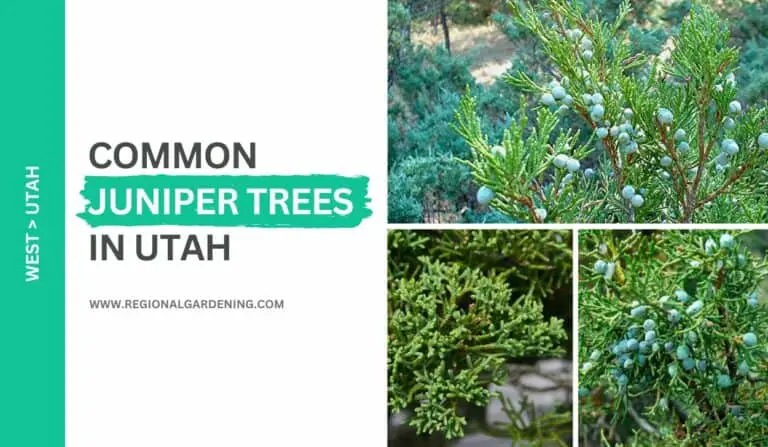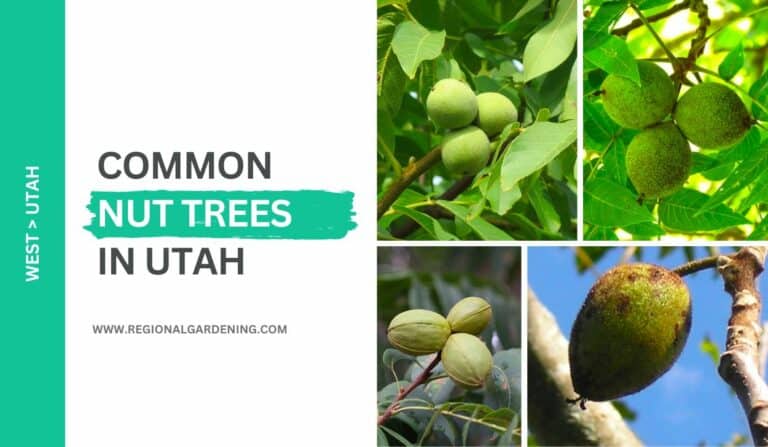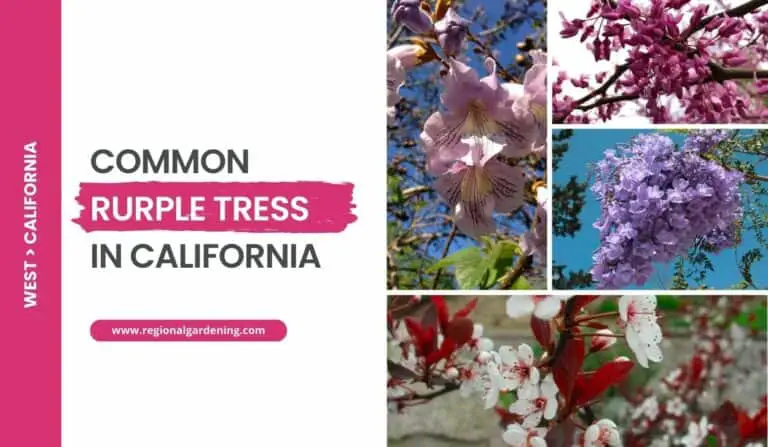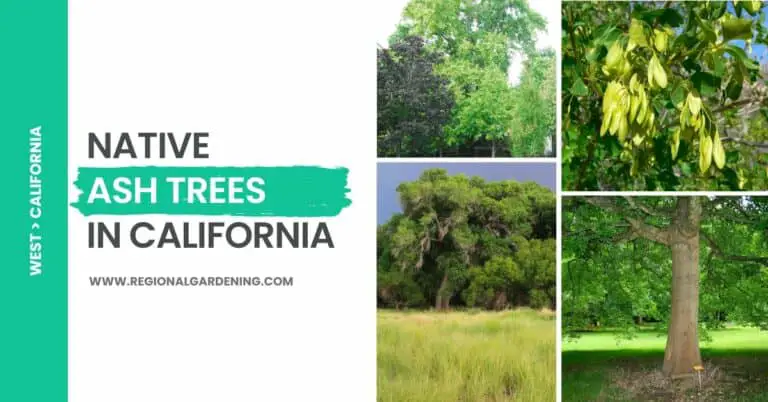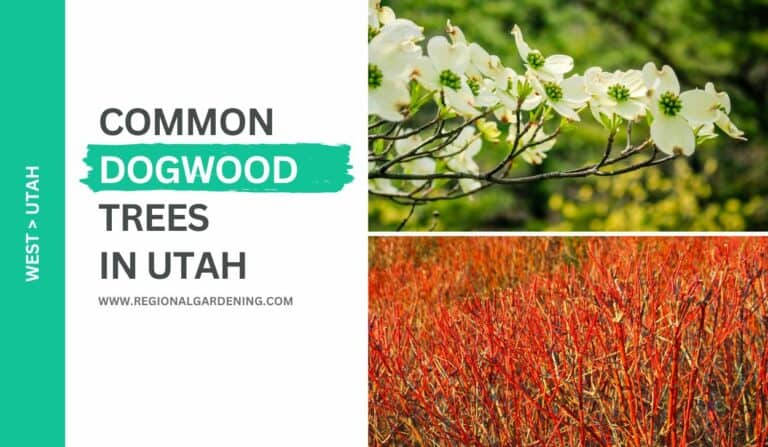9 Common Plum & Cherry Trees In Utah (Photos & Descriptions)
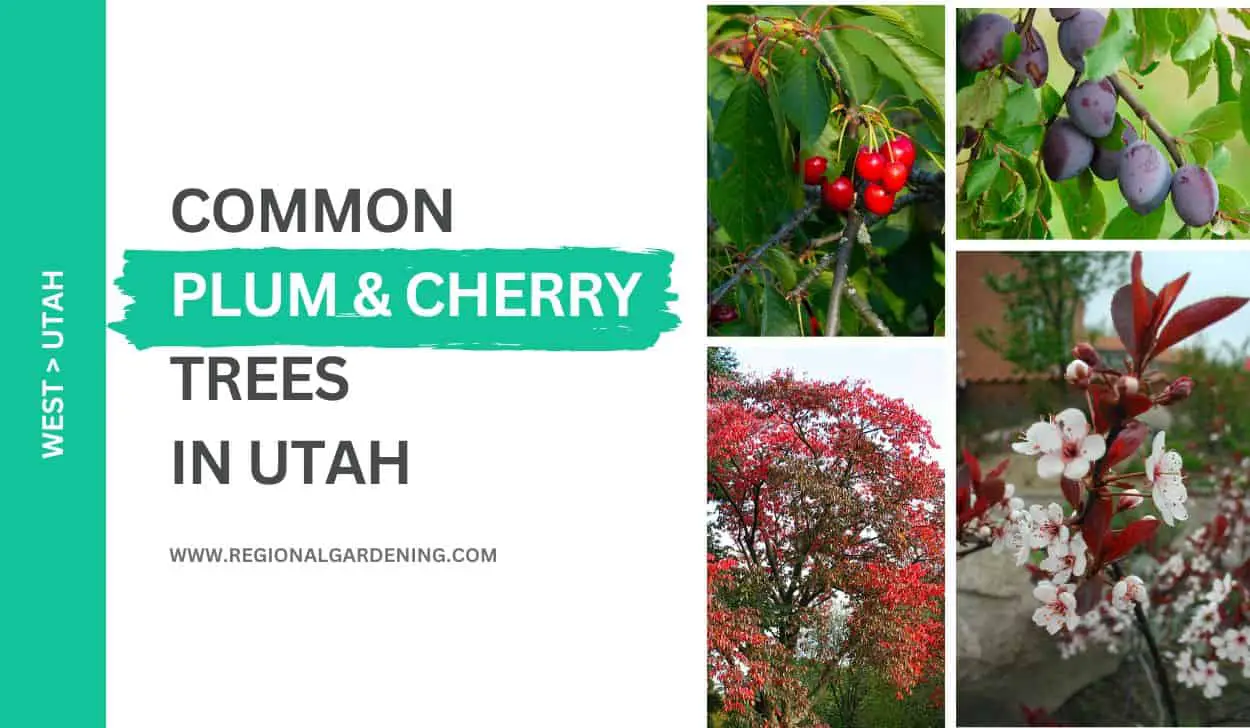
The flowering trees that adorn Utah’s diverse landscape are numerous, with the common cherry (Prunus avium) and plum (Prunus domestica) trees standing out as enchanting highlights.
These graceful deciduous trees grace the region with their vibrant blossoms and delectable fruits, weaving a colorful tapestry that captivates both nature enthusiasts and fruit lovers.
In this article, we delve into the allure of these endearing trees, investigating their distinct characteristics, cultural significance, and applications in gardening and daily life.
So, let us begin exploring the abundant beauty of cherry and plum trees in Utah’s picturesque state.
Common Cherry Trees In Utah
1. Common Chokecherry
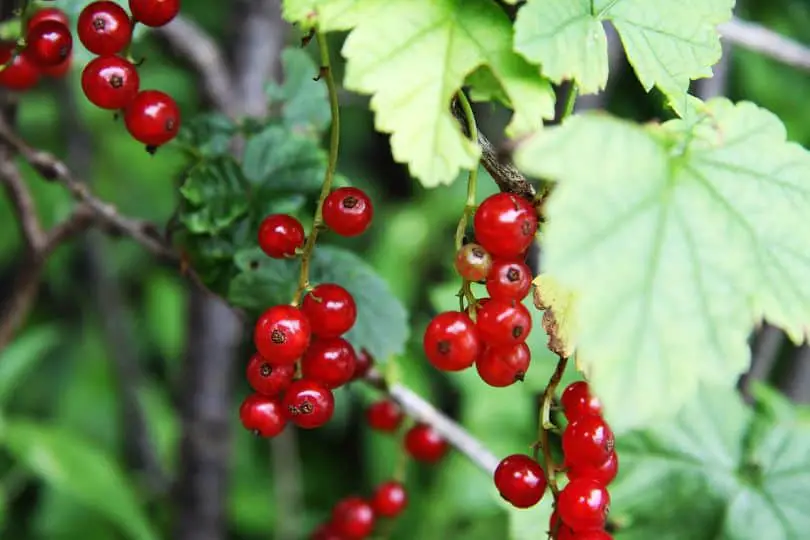
- Common Name: Chokecherry
- Scientific Name: Prunus virginiana
- Mature Height: 30ft
- Native/Non-Native: Native to most of the continental U.S. and Canada
- Flowers/Cones: Small white flowers in elongated bunches; spherical, black fruit
- Uses: Edible fruit, wildlife habitat plantings, windbreaks
Chokecherry, also known as Prunus virginiana, is a natural plant that may be found throughout the United States and Canada. It is a medium-sized tree or huge shrub that can reach a height of 4 feet. Chokecherry leaves are dark green on top and lighter underneath. They have a serrated edge and are oval to obovate.
Chokecherry twigs are slender and silver-gray as they age. They have little spherical lenticels, which are small gas exchange holes. The twig buds are scaly and red-brown in hue.
The Chokecherry bears little white blossoms in elongated bunches in May. These blossoms eventually develop into spherical, black fruits about a third of an inch in diameter. The fruit is edible, although it tastes sour.
When the tree is young, the bark of the Chokecherry is smooth and red-brown. The bark turns gray-black with age and remains smooth with visible lenticels. The wood of the Chokecherry tree is not particularly valuable and is seldom known.
The chokecherry is a hardy plant that may grow in a variety of conditions. It favors moist, rich soil, but it can also thrive in lesser soil conditions. It does not, however, tolerate shade well.
Because of its lovely blossoms and modest size, the Chokecherry is widely utilized in landscaping. It is frequently planted for wildlife habitats and windbreaks. Chokecherry fruit can also be used to produce jams and jellies.
2. European Bird Cherry
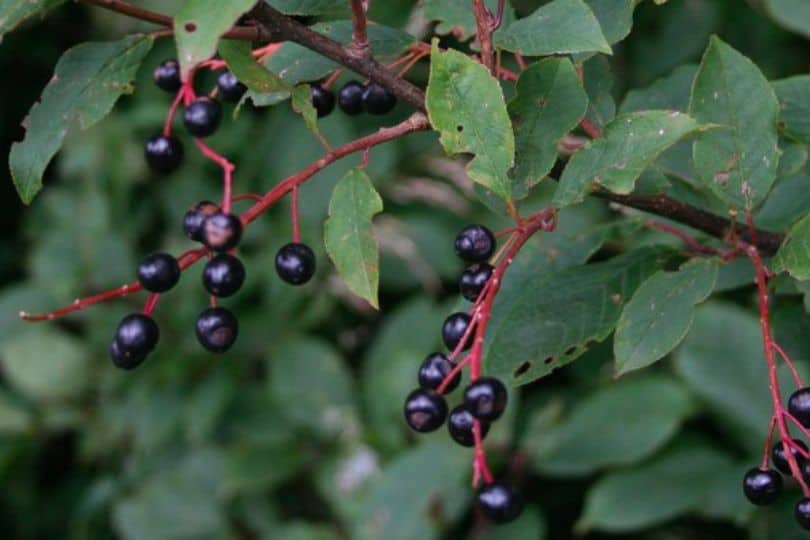
- Common Name: European Bird Cherry
- Scientific Name: Prunus padus
- Mature Height: 50ft
- Native/Non-Native: Native to Europe, Asia, and Japan
- Flowers/Cones: Fragrant 1/2″ white flowers in elongated, drooping bunches appearing in early May. The fruit is a 1/4″ to 1/3″ diameter black drupe maturing in mid to late summer.
- Uses: Various crown and inflorescence sizes and foliage colors are available.
The European Bird Cherry, also known as the May Day Tree or Prunus padus, is a small to medium-sized tree distributed throughout Europe, Asia, and Japan. The petiole of its leaves has two or more glands or bumps.
The tree blooms with gorgeous and fragrant white flowers approximately half an inch in size in early May. The pleasant aroma of these flowers fills the air as they hang down in large bunches. The European Bird Cherry also produces little black fruits known as drupes in the summer. These drupes range in size from a quarter to a third of an inch in diameter and ripen in the middle to late summer.
The European Bird Cherry is widely utilized in landscaping, despite certain difficulties. It is shade-intolerant and sensitive to the disease black knot. However, because of the range in crown and inflorescence sizes, as well as foliage hues, it remains a popular choice.
Gardeners and landscapers can select from a variety of European Bird Cherry cultivars to obtain the desired look in their landscapes. It is vital to note that the tree is best suited for zones 3 to 7, implying that it flourishes in those climate zones.
Finally, the European Bird Cherry is a lovely tree with aromatic blossoms and little black fruits. It is common in landscaping and can be found throughout Europe, Asia, and Japan. Despite several drawbacks, such as shade intolerance and susceptibility to black knot disease, it is still a popular choice due to its wide range of leaf colors and sizes.
3. Sour Cherry
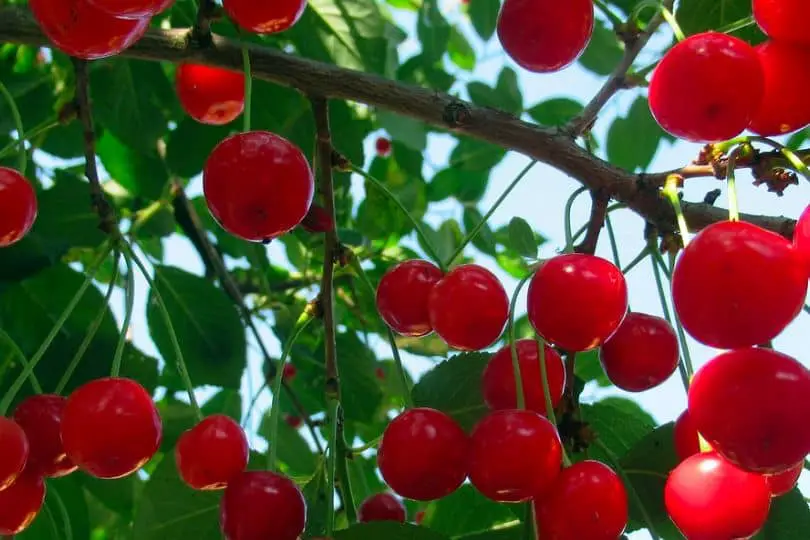
- Common Name: Sour Cherry
- Scientific Name: Prunus cerasus
- Mature Height: Up to 15ft
- Native/Non-Native: Native to Europe and Asia, but cultivated worldwide
- Flowers/Cones: White flowers, small clusters; red juicy fruit
- Uses: Grown for “pie cherries”
The Sour Cherry, formally known as Prunus cerasus, is a tiny tree that can grow to be 2 to 3 feet tall when mature. It is a plant native to Europe and Asia, but it has been cultivated and grown all over the world. Sour Cherry leaves are double-serrated and are 2 to 3 inches long. The undersides of the leaves have a mild hairy texture, and the petiole lacks glands.
The Sour Cherry has lovely white blossoms that range in size from 1/3 to 1/2 inch. These blooms grow in little clusters and lend an elegant touch to the tree. The Sour Cherry fruit is a huge, brilliant red drupe. It is juicy and tangy in flavor, making it a favorite pie filling.
The Sour Cherry’s bark is lustrous and layered, with noticeable horizontal ridges or lenticels that give it a distinguishing appearance. This tree is frequently planted in orchards for its wonderful pie cherry. There are, however, superior species available if you are searching for a tree for ornamental purposes.
The Sour Cherry has intermediate shade tolerance, which means it can tolerate some shade but prefers full sun. It is hardy in zones 3-9, making it adaptable to a variety of climates. So, if you want to cultivate your pie cherries or simply add a lovely blooming tree to your garden, the Sour Cherry can be a good choice.
4. Sweet Cherry
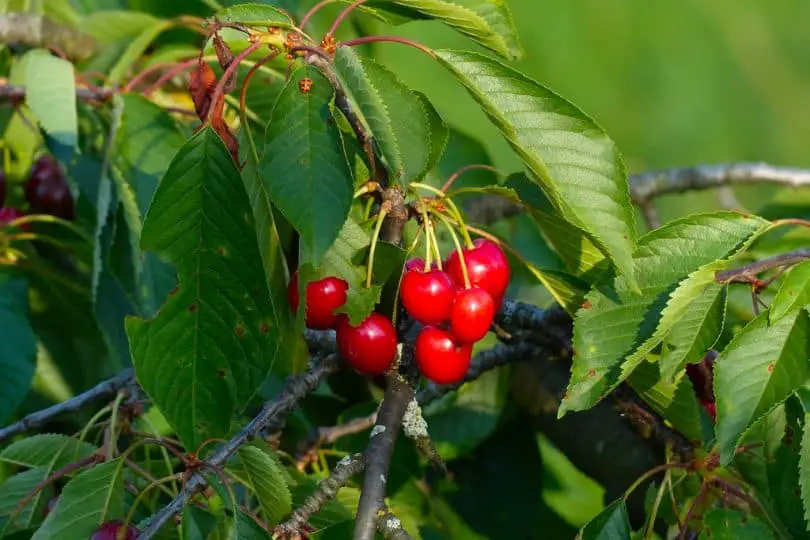
- Common Name: Sweet Cherry
- Scientific Name: Prunus avium
- Mature Height: 30-35ft
- Native/Non-Native: Non-Native
- Flowers/Cones: White flowers
- Uses: Can be used for its fruit
The Sweet Cherry, or Prunus avium, is a tiny tree that is widely grown for its wonderful fruit all over the world. It is native to Europe and Asia, however,r it can be found in a variety of nations.
Sweet Cherry leaves range in length from 2 to 6 inches and have a serrated edge. They feature tiny hairs on the underside of the leaves as well as two glands near the stem.
The tree produces clusters of fragrant white blooms about 1 inch in size in the spring. Bees and other pollinators adore these blooms.
The blossoms will have matured into huge, luscious dark crimson fruits by late summer. These fruits are recognized for their sweet taste and are popular among both people and animals.
The Sweet Cherry tree’s bark is lustrous and contains visible ridges or lenticels. This gives the tree a distinct and intriguing appearance.
It should be noted that the Sweet Cherry tree does not thrive in shaded locations. It prefers to be out in the open.
Although the Sweet Cherry is often planted in orchards for its fruit, other species of cherry trees are better suited for ornamental purposes. These trees are frequently utilized in landscaping to enhance the aesthetic of outdoor settings.
5. Sargent Cherry
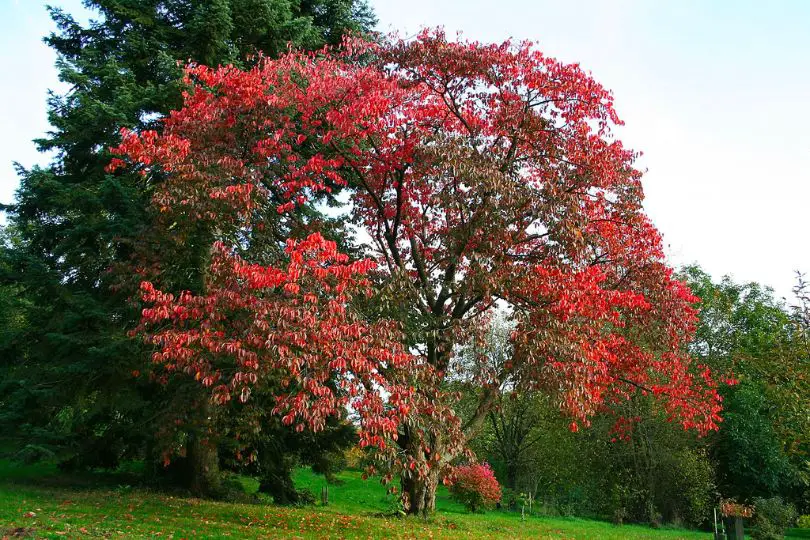
- Common Name: Sargent Cherry
- Scientific Name: Prunus sargentii
- Mature Height: 25-35ft
- Native/Non-Native: Native to Japan
- Flowers/Cones: Pink flowers in small clusters, purple to black drupe fruit
- Uses: Good landscape tree, attractive bark, displays good fall color
The Sargent Cherry, Prunus sargentii, is a lovely tree that grows to a medium height. It has a very lovely reddish-brown bark with noticeable horizontal ridges. This tree is native to Japan and thrives in USDA zones 4-7.
Sargent Cherry leaves are 3 to 5 inches long and have a smooth underside. On the petiole, there are two to four conspicuous glands near the leaf blade. The tree blooms in late April or early May with clusters of exquisite pink flowers. Bees and other pollinators are drawn to these flowers. Small purple to black drupes emerge as the blossoms fade. These little fruits have a diameter of about one-third of an inch.
Shade intolerance is one of Sargent Cherry’s distinguishing characteristics. It prefers direct sunlight and does not grow well in highly shady locations. As a result, it is preferable to plant this tree in open areas with ample sunlight.
The Sargent Cherry is a popular landscaping choice because it offers beauty and elegance to any outdoor setting. It stands out due to its beautiful bark and vibrant fall hues. Despite its numerous appealing characteristics, Sargent Cherry is not widely employed in landscapes and should be.
6. Japanese Flowering Cherry
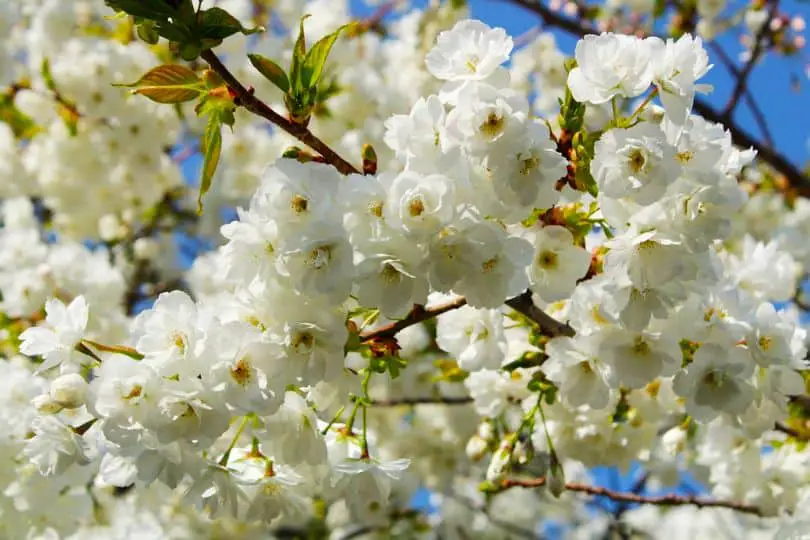
- Common Name: Japanese Flowering Cherry
- Scientific Name: Prunus serrulata
- Mature Height: 15-25ft
- Native/Non-Native: Native to China, Japan, and Korea
- Flowers/Cones: Pink (some cultivars white), 1/2″ to 2-1/2″ single or doubled flowers in small clusters
- Uses: Prized for its beautiful flowers
The Japanese Flowering Cherry is a tree native to China, Japan, and Korea. It is also known as the Oriental Cherry or Prunus serrulata. It is commonly cultivated for its gorgeous flowers all over the world.
The leaves of the Japanese Flowering Cherry are long and pointed, with bristle-tipped teeth. They are typically 2 to 5 inches long, with a smooth underside. Pink blooms (some varieties have white blossoms) range in size from 1/2″ to 2-1/2″. When the leaves begin to grow in April, these flowers appear in tiny clusters.
The tree also produces little black fruits known as drupes, which are often absent or limited in number. The Japanese Flowering Cherry’s bark is lustrous, gray-brown, and peels horizontally.
The Japanese Flowering Cherry is highly valued in landscaping because of its lovely blossoms. Although it can grow on its roots, the tree is commonly grafted several feet above the ground on a sweet cherry rootstock.
The Japanese Flowering Cherry has good golden to crimson fall colors, which add to its autumn charm. While the tree has ornamental value and is beneficial to wildlife in its natural habitat, it can be susceptible to a variety of illnesses in cultivated landscapes.
Nonetheless, it is a popular garden plant that may be cultivated in USDA hardiness zones 5 to 9.
7. Higan Cherry
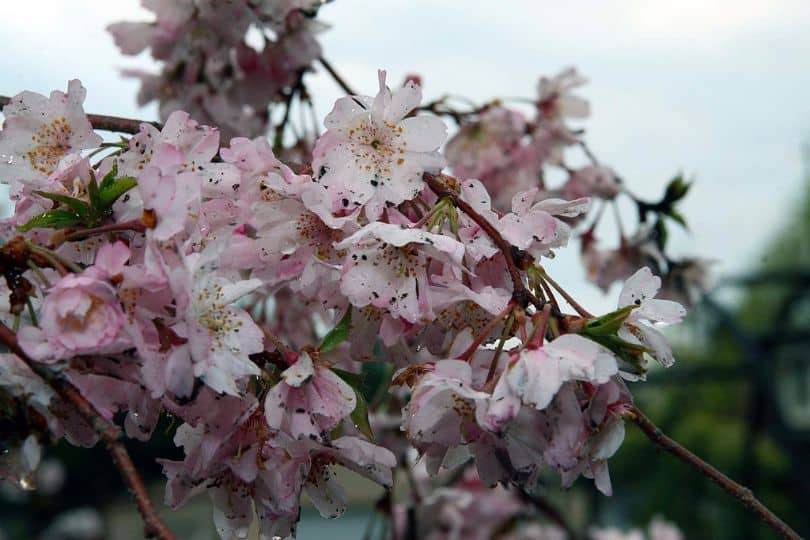
- Common Name: Higan Cherry
- Scientific Name: Prunus subhirtella
- Mature Height: Small to medium-sized tree
- Native/Non-Native: Native to Japan
- Flowers/Cones: Pink or white, single or double flowers. Small groups of flowers open in March or April before the leaves.
- Uses: Landscaping purposes.
Higan Cherry (Prunus subhirtella) is an enthralling deciduous tree known for its stunning beauty and ornamental significance. This beautiful cherry tree, native to Japan, has found its way into landscapes all around the world due to its endearing qualities.
Higan Cherry has a lovely, spreading canopy with arching branches reaching heights of 20 to 30 feet. Its leaves are simple, serrated, and ovoid, with a lustrous dark green color in the summer and a bright mix of orange, yellow, and red in the autumn, creating a magnificent display of colors. The smooth, reddish-brown bark contrasts beautifully with the surrounding foliage.
The Higan Cherry’s exquisite pink or white blooms are one of its most appealing qualities. This tree blooms in early spring, gracing the tree with a profusion of petals that attract bees and butterflies, making it a wonderful choice for pollinator-friendly landscapes.
Following the flowers, the tree produces small, spherical red to black fruits. Due to their slightly bitter flavor, these cherries are typically not consumed by humans, which makes the tree more alluring to lovers of wildlife.
Higan Cherry thrives in a variety of soil types and light conditions in its native region, making it flexible and simple to cultivate. As a result, it is frequently used in landscaping projects to provide an elegant touch to gardens, parks, and streetscapes. Furthermore, because of its beautiful appearance, it is a popular choice for ornamental gardens and Japanese-inspired landscapes.
Higan Cherry performs important ecological functions in addition to its visual appeal, supplying food and habitat for birds and insects. Furthermore, because of its endurance and small size, it is a wonderful addition to urban environments, where it may provide shade and improve the general microclimate.
Common Plum Trees In Utah
1. Purpleleaf Plum
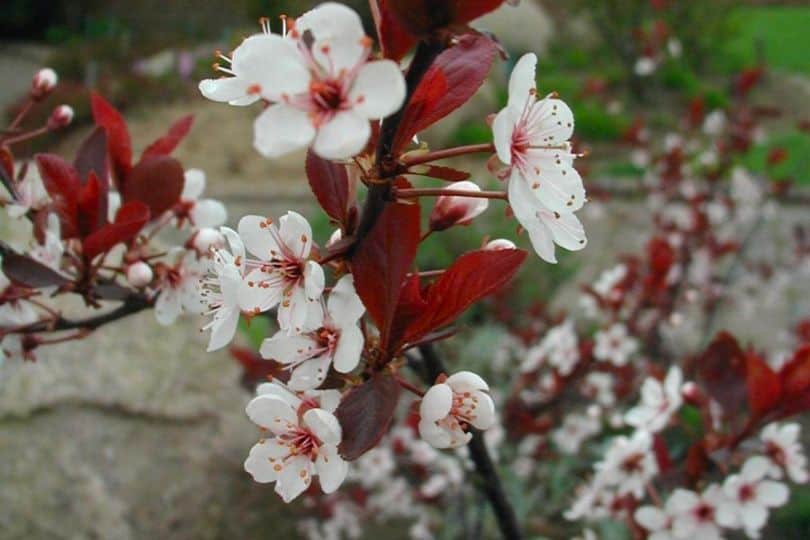
- Common Name: Purple leaf Plum
- Scientific Name: Prunus cerasifera
- Mature Height: 25ft
- Native/Non-Native: Non-Native
- Flowers/Cones: Flowers
- Uses: Edible fruit, ornamental tree
Purple leaf Plum, also known as Cherry Plum or Myrobalan Plum, is a tiny tree used in landscaping. It has oblong to obovate alternating leaves that measure approximately 1-1/2″ to 2-1/2″ long. The leaves are deciduous and often purple-green to dark purple, though they can sometimes be dark green. Except for small hairs along the veins beneath, the surface of the leaves is smooth both above and below. The leaf edges are serrated, and glands may be present where the petiole connects to the blade.
The tree’s slender twigs are silver-gray when young and dark gray as it ages. The twig buds are about 1/4″ long, scaly, and a dark purple-gray color. The Purpleleaf Plum blooms in early spring with stunning pink or white blossoms that are 3/4″ to 1″ in diameter.
The tree also produces fruit, which are circular drupes (plums) around 1″ in diameter. The plums have a dark purple color and a sweet, delicious flavor. They reach maturity in mid-summer and are normally in tiny numbers.
Purpleleaf Plums are grown not just for their fruit but also for their decorative appeal. It is commonly used in landscaping and can be seen in parks and gardens. It is crucial to remember, however, that this tree is shade intolerant and may have pest problems.
While the Purpleleaf Plum is a popular choice for landscaping, other little blooming trees may be more suited for specific settings. Before choosing this tree for a garden or yard, it is recommended that you investigate other options.
2. Common Plum
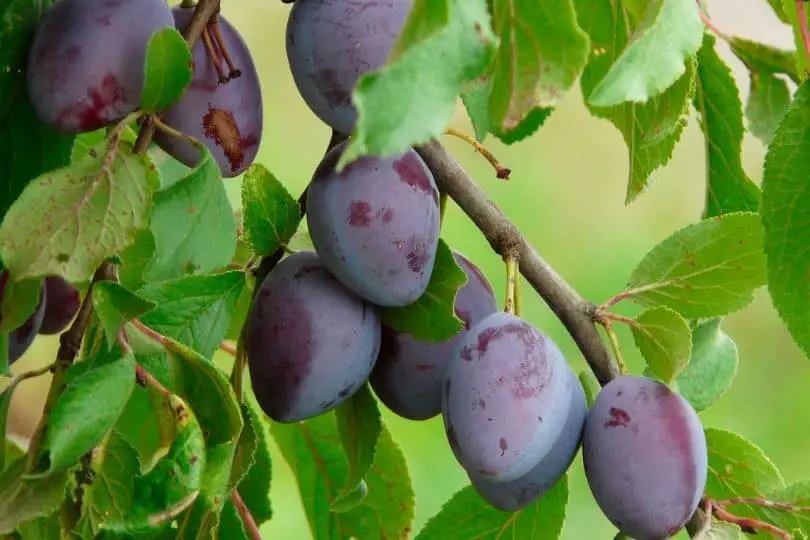
- Common Name: Common Plum
- Scientific Name: Prunus domestica
- Mature Height: Up to 20 feet tall
- Native Range: Native to regions of Europe and Southwest Asia.
- Flowers/Fruits: Small, white clustered flowers in early spring; succulent and sweet plums in various colors when ripe.
- Uses: Plums are used for culinary purposes, fresh consumption, preserves, jams, beverages, and medicinal uses. The tree is planted = for landscaping and wildlife support as well.
The common plum (Prunus domestica) is a highly popular fruit-bearing tree that thrives in the diverse landscape of Utah. Renowned for its bountiful harvest of flavorful fruits, this tree is cultivated in numerous varieties and forms throughout the region. Its distinctive physical traits make it easily recognizable in the Utah landscape.
One of the key identifying characteristics of the common plum is its shiny silver-gray bark, adorned with prominent horizontal lenticels. This bark adds a touch of elegance to the tree’s appearance and serves as a distinguishing feature. The leaves of the common plum are typically ovate, with serrated edges, showcasing vibrant shades of green during the growing season.
The fruit of the common plum is highly prized, known for its delectable taste and versatility in culinary applications. It comes in a wide range of colors, including red, purple, yellow, and green, depending on the specific cultivar. The sweet, juicy flesh of the plum surrounds a single pit, which is carefully encased within the fruit.
The common plum is well-suited to Utah’s climate, thriving in USDA hardiness zones 4-9. While its exact native range is uncertain, it has been widely cultivated and naturalized across various regions, including Utah. This tree is adaptable and can thrive in a variety of habitats, displaying its resilience and versatility.
Similar Articles
- Common Oak Trees in Utah
- Common Pine Trees In Utah
- Common Magnolia Trees In Utah
- Common Ash Trees In Utah
- Common Spruce Trees In Utah
- Common Elm Trees In Utah
- Common Birch Trees In Utah
- Common Poplar Trees In Utah
- Common Maple Trees In Utah
- Common Dogwood Trees In Utah
- Common Nut Trees In Utah
- Common Cedar Trees In Utah
- Common Willow Trees In Utah
- Common Alder Trees In Utah
- Common Cypress Trees In Utah
- Common Beech Trees In Utah
- Common Juniper Trees In Utah
- Common Fir Trees In Utah
- Common Palm Trees In Utah
Common Plum & Cherry Trees In Utah – Sources
The Regional Gardening team makes sure that the information in our articles is accurate by only using sources that are known to be trustworthy. Some of these sources are peer-reviewed journals from government agencies, well-known universities, and scientific research organizations.
- Trees & Shrubs In Yard And Garden, Utah State University Extension
- Native & Non-Native Tree Identification, Utah State University Forestry Extension.
- Native Plants, Utah Native Plant Society.
- A Guide To The Trees Of Utah & Intermountain West, Book By Michael Kuhns, Utah State University Press.


